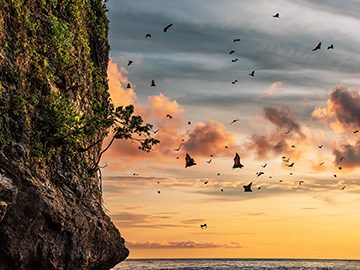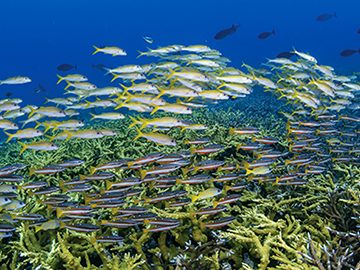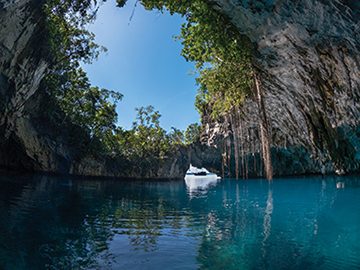Developing a new dive destination
JUST BEFORE SUNRISE I make a cup of strong Indonesian tea and feel the familiar rush of anticipation that always builds when I dive where no one else has. From the liveaboard’s top deck I squint at a string of islands — just green dots from here — that stretch offshore from the Fakfak Regency, which lies between Raja Ampat and Triton Bay in Indonesia’s West Papua province.
My shipmates and I are here to explore this expanse of undocumented reefscape and find enough captivating activities to develop Fakfak for adventure tourism. Our goal is to add Fakfak as a dive destination among the region’s trinity: Raja Ampat, Triton Bay, and Cenderawasih Bay.
Our goal is to add Fakfak as a dive destination …
Before this trip, liveaboards traveling between Raja Ampat and Triton Bay had largely ignored Fakfak, which had only two recorded sites: one around Pisang, a small island group northwest of Fakfak, and another near Mommon, a spectacular waterfall in the south. But a destination needs more than a few sites. Travelers will look for locations that offer several days’ worth of diving and have maps and site descriptions available. Photographs and articles will create a buzz about the area. All the site organization and publicity, however, may still take a couple of years to convince people to travel halfway around the world to dive at the newest hot spot, so the development work must start early.
Having spent many years establishing resorts and liveaboards in remote areas, I’m well versed in most aspects of dive destination development. At this stage in my life I know I was fortunate to get to these places early and that my sense of adventure led me to introductions to the right people and made me willing to take a chance on diving in an uncharted area. Wanderlust took me to Mexico’s Quintana Roo coast in the early 1970s, the Solomon Islands in the late 1980s, and Komodo National Park in the early 1990s.
Development and Preservation
In late 2002 I headed to Raja Ampat after reading a rapid assessment survey that described the reefs surrounding West Papua’s Raja Ampat Regency as the most biologically diverse in the world. My first day of diving there confirmed it — I had never seen reefs like those.
While I was chartering liveaboards, a consortium of international nongovernmental organizations (NGOs) — including Conservation International, The Nature Conservancy, and World Wildlife Fund-Indonesia — worked closely with local communities and the government to form a conservation initiative. Known as the Bird’s Head Seascape (BHS), it included Raja Ampat, Triton Bay, and Cenderawasih Bay, Indonesia’s largest marine park. One of the initiative’s early successes was establishing the Bird’s Head marine protected area (MPA) network, which now consists of 26 MPAs covering more than 20,000 square miles.

group to feed at sunset.
JONES–SHIMLOCK/SECRET SEA VISIONS

JONES–SHIMLOCK/SECRET SEA VISIONS
It didn’t take long for stories and photographs about Raja Ampat’s reefs to spread. By 2008 liveaboards were queuing at popular sites, and diver impact was noticeable. Mark Erdmann, PhD, Conservation International’s senior advisor for Indonesian marine programs at the time, offered me a dream job. I’d have access to a liveaboard, a couple of scooters, and a budget to explore the furthest reaches and publish a Raja Ampat dive guide. Mark believed that discovering additional sites would relieve diving pressure and encourage liveaboards to visit remote areas, where their presence could deter illegal fishing.
Diving Indonesia’s Raja Ampat came out in 2009, and a second guidebook, Diving Indonesia’s Bird’s Head Seascape, followed in 2011 and included Triton and Cenderawasih bays. Conservation International’s website for BHS (birdsheadseascape.com) incorporated all the information from the books and provided new content. Sustainable tourism development became an official part of the BHS conservation strategy.
As we turn we see a large, curious oceanic manta following in our wake. We gently circle back and cruise with the manta, eye to eye, for what seems like a very long minute.
Exploring Fakfak
A light breeze was blowing as Mark joined me on the liveaboard’s top deck, carrying his ever-present French press travel mug. The COVID-19 pandemic had delayed this exploratory trip for two years, and the wait seemed interminable. Mark told me that the Fakfak government has anticipated our assistance in developing tourism opportunities since 2018. That year the Ministry of Marine Affairs and Fisheries had formalized the regency’s two new MPAs and the governor of West Papua had officially recognized the extension of the Bird’s Head MPA network.
“We surveyed this area from a biodiversity perspective in 2006 and again in 2018,” Mark explained. “We documented spectacular species diversity but didn’t focus on tourism potential. I feel confident the team we’ve got now will produce enough content to attract adventure tourism to Fakfak.”
Mark and I had assembled a dream team of intrepid divers focused on distilling this journey into the elements necessary to attract visitors to Fakfak. Besides flying a drone, photographing, and watching for new fish species, Mark would keep a journal of each dive site’s details. Also with us is my old buddy Gerald Allen, PhD, the scientist responsible for first calling attention to the region’s spectacular fish diversity and arguably the world’s foremost tropical ichthyologist. Sarah Lewis, a manta conservationist and founder of the Indonesian NGO Thrive Conservation, is here to assess the potential for shark and ray tourism development in Fakfak.
We have an entire team charged with producing content. Garry Bevan, a Brit based in Indonesia, will make detailed dive site maps for the BHS website. Joel and Jennifer Penner are website developers, videographers, and still photographers who own New Media Soup and provide tech support for the website. A promotional film for the Fakfak government is in the hands of Luca Vaime and Mike Veitch, Bali-based videographers and still photographers who run Underwater Tribe.

JOEL PENNER/NEW MEDIA SOUP

JONES–SHIMLOCK/SECRET SEA VISIONS
Local NGO Konservasi Indonesia has an impressive team on board to interpret our findings for the Fakfak government and local communities and provide input on domestic tourism potential. Led by West Papua program director Meity Mongdong and Kaimana-Fakfak corridor manager Ismu Hidayat, the team includes Meidarti Kasmidi, Susan Vulpas, Permenas Mambrasar, Bertha Matatar, Yakonias Thonak, Johanis Toisuta, and partners Ramlie Salihi (head of the Fakfak MPA Management Authority) and Isak Samori of the West Papua Ministry of Environment and Forestry. Many team members have been at the forefront of developing the BHS initiative for nearly two decades.
Edi Frommenwiler, the liveaboard’s owner, steps from under the canvas shade to watch the current patterns streaking the sea’s smooth surface. He was also with us for the initial 2002 Raja Ampat survey. He agrees we should check out a labyrinth of reefs that our ancient charts tell us are just off the bow. Mark decides to launch his drone for a quick aerial survey before the diving day begins. After a short flight, Mark quickly downloads the images. Visibly excited about the seamount his drone footage reveals, he says, “I think we should concentrate here, where the current is strongest, and there might be some schooling fish action.”
Edi and I agree and start mobilizing the teams to fill each dinghy. Everyone, especially the Indonesian contingent, is moving slowly. We had stayed up late a couple of nights ago, dancing and singing with locals in Kokas at a lavish welcome party on the beach. And last night the liveaboard hosted a dinner for the vice regent of Fakfak, and our Indonesian team talked until the wee hours about the survey findings that could attract tourism: spectacular waterfalls, huge swaths of old-growth forests, impressive limestone caverns, and beautiful shallow coral gardens perfect for snorkelers.

A new species of fang blenny (Meiacanthus sp.)
GERALD ALLEN
I will have a dinghy to myself, my only passenger being an underwater scooter. Although photography is my passion, my mission is to explore, so I have few opportunities to carry my camera. The rest of the divers fill the other two tenders. Each boat carries a GPS, and the drivers mark entry and exit points. The dive guides will surface if they encounter a vibrant area, and the tender driver knows to mark these points.
After grabbing a piece of toast for breakfast, I’m ready to investigate the area Mark suggested. By the time I pull away my boat, Joel has launched his drone and tells me via radio that he’s found a ridge of coral leading from the mount into deeper water. Dropping into the water, I am amazed by the number of fish milling around the top of the coral dome 26 feet below. As I descend, the fish separate, revealing an intricate maze of healthy hard corals. I quickly steer toward the ridge, which is as lush with life as the mount. I use my scooter to survey 10 potential areas before finding a single dive for the mapmakers and film crew to check out, but I’m one for one this morning and want everyone to see this site.
The current picks up a bit, which usually means more fish. It’s hard not to be jealous when other divers come back raving about their images. “That ball of surgeonfish nearly swallowed Luca,” Mike said. “I lost him between the schools of fusiliers and the bannerfish.” Joel and Jennifer agree the fish are as dense here as any place they’ve ever dived.
It is difficult to leave an extraordinary site to move to another unknown, but we aim to cover as much area as possible, which means not lingering, no matter how amazing the experience. With its tenders leading the way, the liveaboard motors to a long finger of land pointing south. As close as we have been to civilization, we have seen very little plastic debris. Clean and neatly swept villages and beaches gleam as we pass. In Batu Putih Bay we find an area with excellent coral cover and a stunning density of moon jellyfish. Jennifer admits to being awestruck by their sheer number as well as hesitant to be in the middle of so many jellyfish, even though she knew they were mostly stinger-free.

A brilliantly colored male redheaded wrasse (Halichoeres rubricephalus) that is normally found in deep water
MARK ERDMANN

A new species of coral blenny (Escenius sp.)
GERALD ALLEN

This rarely encountered juvenile masked grouper (Gracila albomarginata) is extremely shy and normally inhabits caves.
MARK ERDMANN
We decide to move farther south toward Tanjung Tongerai, close to the area where Gerry and Mark made a record count of 388 fish species during the 2018 assessment. On this current exploration, they photograph what they believe are four new fish species.
Susan meets me on the dive deck. She is a relatively new diver and is curious about my scooter; she has never used one, so I invite her to buddy with me. She hangs on as we descend, slowly idling over a shallow reef dense with parrotfish and snappers. As we turn we see a large, curious oceanic manta following in our wake. We gently circle back and cruise with the manta, eye to eye, for what seems like a very long minute.
After dinner Edi turns the boat north toward Sorong. With a following wind, the boat rolls gently over swells as the team meets for one last debrief before traveling home and writing individual reports. We all agree that developing Fakfak will be easy enough from a dive perspective. There is enough good diving here to attract liveaboards traveling between Raja Ampat and Triton Bay, especially when snorkelers and people who like land-based adventures are on board.
Exploration for developing an area for tourism is not a one-way street paved with daily thrills. As with all expeditions, we had to do the grunt work of planning our trip. On this particular endeavor we dealt with a two-year delay; once we finally got there, we endured days of boredom and disappointment while we searched for a predictably great site in an unpredictable environment. We surveyed about 100 miles of reef. My scooter surveys — exhausting work that yields precious few rewards — accounted for about 60 of those miles.
Memorable encounters such as the spectacular seamount, the manta encounter I shared with Susan, or the 20-foot whale shark our Indonesian team swam with near Tanjung Tongerai make the less-thrilling parts worth it. Those are precisely the kinds of unpredictable yet astonishing experiences we hope Fakfak can deliver to future tourists.
As advocates for implementing tourism as a conservation tool, we must ensure our findings will benefit local communities and the environment. With two new MPAs and government-supported conservation regulations approved, Fakfak is well-positioned to take its place as another stellar attraction within Indonesia’s incomparable Bird’s Head Seascape. AD
EXPLORE MORE
See more of Fakfak in a bonus online photo gallery and this video.
© Alert Diver — Q4 2022